#young christian martyr
Text

#art#steel engraving#famous#young christian martyr#Heiligenschein#after paul delaroche#pommer#Christliche Märtyrin 1864
263 notes
·
View notes
Text




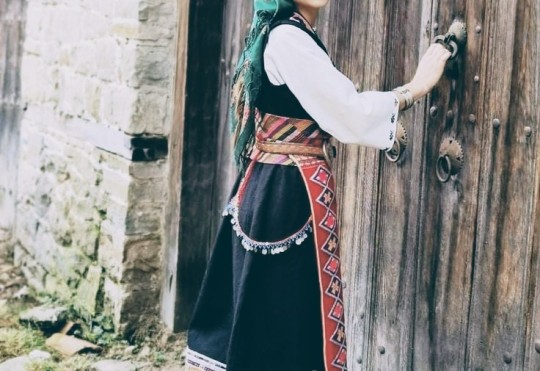



October 26th is Dimìtrovden/Mitrovden (Димитровден), or the Orthodox feast day of St. Demetrius of Thessaloniki. (Bulgarian: Свети Димитър Солунски) He is a 3rd-4th century Christian saint and great martyr (великомъченик) from the city of Thessaloniki in Greece, of which he is the patron saint.
Hagiographies refer to St. Demetrius as a young man of a senatorial family, who became proconsul and was tasked with persecuting Christians in the at the time still pagan Roman Empire. However, being himself Christian, he instead protected them, for which the emperor had him jailed. He was later speared to death as punishment for the defeat of the gladiator Lyaeus at the hands of Demetrius' disciple, Nestor. This marked the beginning of his veneration by Christians in the area, which grew in the following centuries, as he was said to guard the city against raiders.
Albeit not one originally, during the Middle Ages St. Demetrius came to be revered as a warrior saint, and iconography portrays him riding on a red horse, running a spear through various enemies — often Lyaeus, but also whoever was locally perceived as an enemy. In Greek icons, this is sometimes the Bulgarian tsar Kaloyan, while in Bulgarian ones — the Byzantine emperor Basil II The Bulgarslayer, or later on, a Turk. St. Demetrius is also associated with the founding of the Second Bulgarian Tsardom, specifically the uprising of the brothers Petăr and Asen, which broke out on Oct. 26th, 1185. The St. Demetrius church in Veliko Tărnovo (pictured above) was built in commemoration the event, and served as a coronation site of Asen dynasty tsars, who claimed him as their patron.
Traditionally, Dimitrovden marks the end of the seasonal transition from fall to winter, a period which begins on Oct. 14th with Petkovden. Bulgarian folk mythology casts the saints George and Demetrius in the role of twin brothers, whose respective holidays split the year into its warm and cold halves. The latter, elder of the two, ushers in the cold and darkness, as he rides in on his red horse and the winter's first snowflakes sprinkle down onto the earth from his beard. As St. George's opposite and counterpart, he takes on the qualities of a chthonic deity, and thus has connotations to death and the Beyond — under his patronage the so-called Dimitrovska Zadushnica takes place on the Saturday prior to Dimitrovden, one of several such holidays where food is given out in honor of deceased ancestors. Perhaps this is also why, in addition to St. George, folk imagination places him as a brother to Archangel Michael and nephew to St. Paraskeva/Petka.
Dimitrovden is the true end to the year's agrarian cycle — the harvest now over, it's time to put the farm tools away, make sure the animals have shelter and firewood is stocked up. It's also when farmhands and other labourers' contracts expire and they get rehired for the year ahead, which is why the day is also known as Razpust (Разпуст). As with other big holidays, a community-wide celebratory feast is held, and the customary ritual meal (or kurban) is mutton. The biggest ram is chosen, a pair of gold-painted apples are placed onto its horns and those present bow before it, after which it's slaughtered and cooked, and receives a priest's blessing before being served. Festivities are accompanied by music and horo (group dancing), which again has an intended matchmaking function. Namesakes of the saint celebrate the occasion, too — but they're traditionally served a chicken or rooster dish, according to gender. Other foods for Dimitrovden include corn, seasonal fruit and derived dishes, such as apple pita, pestil (a type of plum dessert), rachel (pumpkin syrup), etc.
Another activity which traditionally ends on Dimitrovden is construction work — a new house is supposed to have been completed by then, and the homeowners celebrate by throwing their own feast with a kurban, and inviting friends and relatives to witness the house being blessed by the master mason and the priest. The feast day has therefore been adopted as a career holiday of builders and masons.
The day's connection to the mysterious and otherworldly has inspired various beliefs and rituals of prognostic or divinatory nature, and anything from the weather and moon phases, to the behaviour of farm animals is observed carefully and used to make future predictions. Characteristic is the custom, known as polazvane (полазване), wherein members of the household make note of the first person to visit them, to physically cross the threshold into their home, and interpret them as a portent of things to come. Also, according to old treasure hunting legends, Dimitrovden is when "the sky opens" and buried gold emits a blue-ish flame just above ground.
Dimitrovden is part of the group of holidays, based around the idea of transition and liminality; between fall and winter, between the world of the living and of the dead. The Christian and pre-Christian symbolism intertwine, the martyr death of the saint mirrors the "death" of nature as the earth is covered in snow and daytime engulfed by darkness. And crucially — for a people whose perception of time follows nature's cycles — the coming of winter brings not only a period of calm and rest, but the promise of spring and renewal.
#Bulgaria#Slavic#Balkan#Eastern Europe#Orthodox#folklore#mythology#customs#Dimitrovden#here you go bulgarian halloween pt.2#I am again sorry it's several days later but it took a while to write ok
2K notes
·
View notes
Text

Saint Dorothy
Died 311
Feast Day: February 6
Patronage: horticulture; brewers; brides; florists; gardeners; midwives; newlyweds; love
Saint Dorothy lived in Caesarea (Turkey) during the Diocletian persecution of Christians. Legend has it, that she was ordered to sacrifice to the pagan gods and refused. On the way to her execution, a young lawyer, Theophilus, mockingly asked her for “fruits and flowers from the garden” in which she proclaimed was in heaven. A basket of fruit and flowers was delivered to her by an angel that she gave to young Theophilus, who then converted and was also martyred. That’s why she’s the patron saint of florists.
Prints, plaques & holy cards available for purchase here: (website)
65 notes
·
View notes
Note
@dylan mulvaney post, im sorry tras are backing who?? What child murderer?? Is this chris chan
Recently, there was a school shooting in Nashville that resulted in the deaths of three children and three adults. The children were all nine years old, not even double digits yet. The adults were older and in their sixties.
The shooter was 28 year old Audrey Hale, a trans identified female who had made maps of the school and done surveillance of the building long before she actually attacked. Police found two assault weapons on her person and two shotguns and other weapons in her home on later investigations. She also had plans to go to another school when she was done with that one.
Since the killing of six innocent people, half of them literal children and the other half older people, all of them being harmless, trans rights activists have only been concerned for themselves and how it makes them look. Nothing for the grieving families, nothing for the traumatized children, hell, not even remorse for the children who are dead. It's all about them. If you search Trans Day of Vengence on Twitter or Tumblr, you'll find horrible displays of trans rights activists calling for violence against 'cis' people, mostly women.

Twitter has had to crack down on those posting using the tag trans day of vengeance because they are inciting violence.

The trans rights activists are now trying to make Audrey a martyr for their community, claiming that she was killed because she was trans and not because she was shooting up a school.

There are even groups of trans activists rallying their followers together to get fire arm training. Literally days after school children were killed.

Also lots of images like these are circulating.

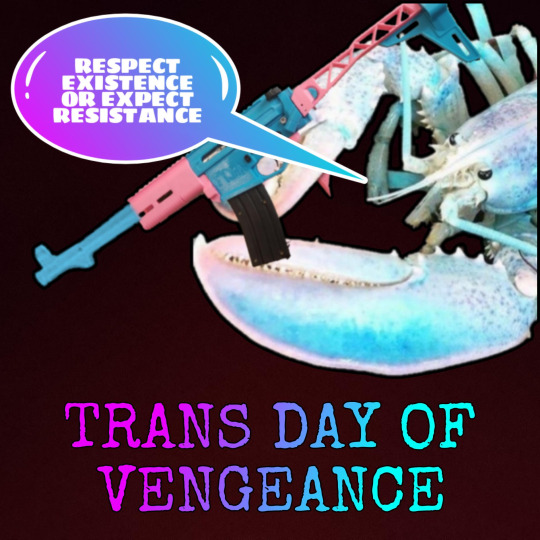

Yes, those are assault rifles. Yes, they have gained popularity after the slaughter of school children in their classrooms. But don't point out that it's incredibly gross to be making the focus yourself after a member of your group killed six people or you get tweets like these

There is so much more and it's frankly disgusting. I know some of my fellow Radfems have already made multiple posts on this and you really should check them out but the fact remains, six innocent people were killed by a trans identified female and all the trans community cares about is themselves. Now, I'm not going to pretend that I like Christianity, or any religion for that matter, but the fact is that nobody deserves to die because of their faith, or their parents faiths as these kids were too young to believe in anything except Santa.
The trans community has rallied around a child murder, who shot up one school and had plans for another. They wound up canceling a protest at the supreme court they had scheduled because they were concerned about bodily harm coming to their protestors. Not because it would be incredibly insensitive after one of their members killed people, but because of possible threats to them.
#radfem#radfem safe#radical feminism#radical feminists please interact#trans#trans men are women#trans women are men#trans depravity#gender critical#gender critical feminism#trans day of vengeance#nashville shooting#gun violence#trans violence#trans violence against children#trans violence against women#sweetselmon#radfems please touch#radfems please respond#trans critical#faminism#trans exclusive radical feminism#woman= adult human female
165 notes
·
View notes
Photo


In Kirsten’s Surprise, Kirsten surprises her family with a St. Lucia Day celebration, a Catholic holiday so popular in Sweden that even the Lutherans kept celebrating it. St. Lucy of Syracuse was a 4th century martyr who brought food to Christians hiding in the Roman catacombs. To light the way and keep both of her hands free, she wore a crown with candles in it. Modern-day celebrations have young girls wearing white dresses to represent the baptismal robe, and a red sash to represent St. Lucy’s martyrdom.
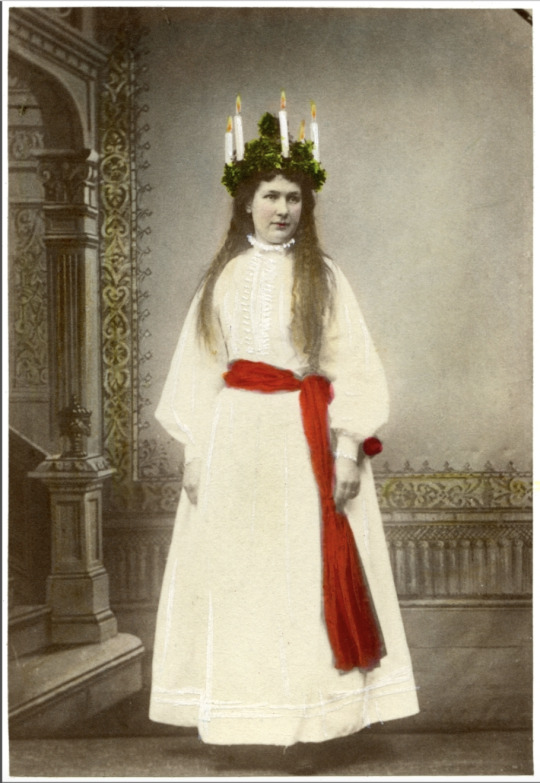
(Nordiska Museet, credit @in-pleasant-company)
If you want to make your own St. Lucia buns, which represent the light of Christ, here’s a recipe!
174 notes
·
View notes
Text
It's an almost banal truism that classic science fiction was largely a projection of the Frontier Experience - and, more broadly, the whole world-shaking events of the European Age of Discovery - onto an imagined outer space. Less frequently remarked is that the reverse is also true.
I grew up devouring Golden Age science fiction novels, and was a fervent believer in Mankind's Destiny Among The Stars. Well, the Space Age - like all the great dreams of thr 20th century - has turned out to be something of a damp squib, but I still want stories of fantastic voyages of exploration, adventure, science, discovery, and intrigue in a vast new world of far-flung outposts separated by titanic distances. So to scratch that itch, why not just...go back to the source?
If you want something like a story about an isolated asteroid mining colony, you can just read the memoirs of a surgeon at a Hudson Bay Company outpost! Why bother with Heinlein when you can just read the diaries of pioneer women, the tales of Yankee filibusters in Latin America, the authentic exploits of desert-island buccaneers, or the early adventures of the Portugese in the Indian Ocean? Do you want fraught tales of inteigue and war and high politics that extend to the farthest reaches of known space? A good book on any of the big 18th century wars for empire will satisfy. And can Star Trek remotely compare in imagination and excitement to the voyages of Cook and La Pérouse? "Strange new worlds, new life, and new civilizations?" Boy howdy, we got 'em! If you look at these things with fresh eyes, with the eyes of a science fiction fan rather than those of someone with access to an infinitide of pictures of them online, nothing could be more surprising than a dugong, a platypus, a redwood, a southern continent of solid ice.
All of this is really just an overly long preamble to my main point, though. Which is that I believe the story of Hernán Cortés, Montezuma, and the Conquest of Mexico to be possibly the greatest one ever told. The themes...bro, the themes! There is here a richness, a complexity and depth surpassing almost anything I can think of in legend or literature.
It is, of course, a science fictional First Contact story, in which two shockingly different civilizations who know nothing of each other suddenly find themselves facing each other down. And indeed, like any good First Contact story, one of the principal characters, La Malinche, is an interpreter! See how the resulting clash of civilizations eludes simple stereotyping - sure, it's easy to see the Spaniards as brash young interlopers into the sophisticated and urbane world of the Aztecs, whose capital was perhaps as much as an order of magnitude more populous than any city in Spain. But equally it is possible to see the Aztecs as provincials, isolated from a wider, older world that suddenly irrupts into their narrow one. Consider that Cortés supposedly got practical advice on political machinations and military strategy by - studying Caesar! Access to ancient wisdom penned by dead hands in far-off lands provides material aid to him.
Then there are the religious themes. It can be seen as a story about the triumph of Christianity, of the Church Triumphant, but what does it mean for a religion founded by a suffering martyr to become militarily triumphant? And what does it mean for thr religion of a suffering martyr to become triumphant over a religion of human sacrifice to the gods? This is a complex and multi-layered irony that spares no one. And consider the strange foreshadowing of the legend of Quetzelcoatl returning from over the sea. Shades of Frank Herbert, here, even (especially?) if the tale is a post-conquest invrntion.
And the role of technology in the tale. Yes, the steel and shot, the horses and hounds, the ships and sails were all powerful allies for the Spaniards, but these would not have sufficed without the smallpox virus - a reversal of Wells that still underlines the power of biology and of the very small even in the face of all our mastery over the brute world. But the conquest also would not have been possible without the alliance with the Tlaxcala and other local rivals and adversaries of the Aztecs. There are very pointed lessons in the social, political, and diplomatic sciences being demonstrated here. Some are obvious, and others very subtle - look at the ways these differing civilizations reacted under the extreme stress of this brutal war to see what I mean about the subtle ones.
I could go on, I could mention the strange aesthetic touches, such as the similarity in climates between the Valley of Mexico and inland Spain, and the parallels between Spain's role to Rome and Mexico's to Spain; or I could talk about the fascinatingly ambiguous characters of all the major players in this story, and the surprising arcs they go through; but not only am I already going on rather long, but I fear I may be making too light of what were, after all, real events, real events that resulted in piles of corpses, and whose tremendous human consequences are still felt deeply by tens of millions of people.
But I stand by my statement that it is one of the richest, profoundest stories I know of. The gods may be cruel, monstrously cruel, but they are artists, too.
18 notes
·
View notes
Text

THE DESCRIPTION OF SAINT PAUL MIKI AND 26 COMPANIONS
Feast Day: February 6
"I am not from the Philippines. I am a Japanese and a Jesuit Brother… Having arrived at this moment of my existence, I believe that no one of you thinks I want to hide the truth. That is why I have to declare to you that there is no other way of salvation than the one followed by Christians. Since this way teaches me to forgive my enemies and all who have offended me. I willingly forgive the king and all those who have desired my death. And I pray that they will obtain the desire of Christian baptism." -St. Paul Miki
The first martyr of Japan, Paul Miki was born to a wealthy Japanese family circa 1562 in Settsu, Osaka Prefecture in Kansai region. At a young age, he entered the Society of Jesus and preached the Gospel successfully.
The church had been implanted in Japan fifty years earlier, and counted over 200,000 Christians. In 1588, the Emperor claimed that he was 'God,' and ordered all Christian missionaries to leave the country within six months. Some of them obeyed, but Paul and many others remained secretly behind.
In 1597, Paul was discovered and arrested along with twenty-five companions. They endured tortures and derision through several towns, with their left ears cut off, before being taken to Nagasaki. After making their confession, they were fastened to their crosses, with iron collars around their necks.
Their valor and bravery were wonderful to behold. They gave thanks to God by singing Psalms 25 and repeating: 'Into your hands, Lord, I entrust my life.'
Standing in the noblest pulpit of the cross, Paul said to the people: 'I am a Japanese by birth, and a Jesuit by vocation. I am dying for the Gospel of Jesus Christ. I do gladly pardon the Emperor, and all who have sought my death. I beg them to seek baptism and be Christians themselves.'
Then, four executioners unsheathed their spears and killed all of them in a short time. Their faces were serene, while they kept repeating: 'Jesus, Mary!'
On June 8, 1862, Pope Pius IX canonized him and his twenty-five companions.
#random stuff#catholic#catholic saints#jesuits#society of jesus#paul miki#paulo miki#pablo miki#peter bautista#pedro bautista#twenty-six martyrs of japan
30 notes
·
View notes
Text


1984 // 2023 → Crown Princess Victoria and her little brother Prince Carl Philip celebrating St Lucia Day, a popular tradition in Scandinavia held in honour of the young Christian martyr Lucia. 39 years later, Victoria's children Princess Estelle and Prince Oscar dress up for their own Lucia celebrations.
#crown princess victoria#prince carl philip#1984#princess estelle#prince oscar#swedish royal family#my upload#2023#December 2023#lucia
25 notes
·
View notes
Text
Happy All Saints' Day to people who we are told received the spiritual espousals; hermits who live with their mothers; name saints of Llandaff cathedral who were never "bishop of Llandaff"; objects of a great and universal popular veneration; remarkable examples of the Christian type of complete "other-worldliness" united with the most capable "practicality"; entirely mythical personages round whom centre some of the most obviously false and preposterous of pseudo-pious romances; sisters who were probably martyred in Italy; people whose brothers try to get them released on the ground that they are out of their minds but who show clearly that they are not and suffer with the rest; young women of Parma who narrowly escape being tried for sorcery; some of the greatest, most attractive, and most widely appreciated women whom the world has ever known; official shorthand-writers; people who have had some very strange experiences, and periodically recurring stigmata, and are often in a state of ecstasy; people killed by the Danes while exhorting them to behave themselves; people who are learned, benevolent, and surpassingly good, beloved by old and young, rich and poor; and people who are quite illiterate but so endowed with wisdom that they are often consulted by educated men.
28 notes
·
View notes
Text
9th part of the bookscans of Al Andalus. Historical Figures, here's the previous part
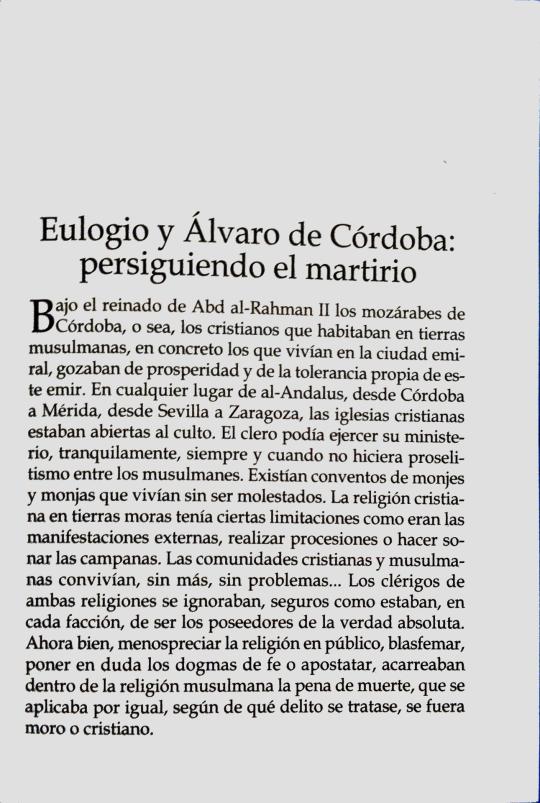
Eulogio and Álvaro de Córdoba:
pursuing martyrdom
Under the reign of Abd al-Rahman II the Mozarabs of Córdoba, that is, the
Christians who lived in Muslim lands, specifically those who lived in the emiral city, enjoyed prosperity and the tolerance typical of this emir. Anywhere in al-Andalus, from Córdoba to Mérida, from Seville to Zaragoza, the Christian churches were open for worship. The clergy could exercise his ministry, quietly, as long as he did not proselytize among the Muslims. There were convents of monks and nuns who lived without being bothered The Christian religion in Moorish lands had certain limitations such as the external manifestations, carrying out processions or ringing the bells. The Christian and Muslim communities lived together, without further ado, without problems... The clerics of both religions ignored each other, sure as were, in each faction, to be the possessors of the absolute truth. Now
well, belittling religion in public, blaspheming, questioning dogmas
of faith or apostatizing, carried within the Muslim religion the penalty of death, which was applied equally, depending on what crime it was, whether if the person was Moor or Christian.
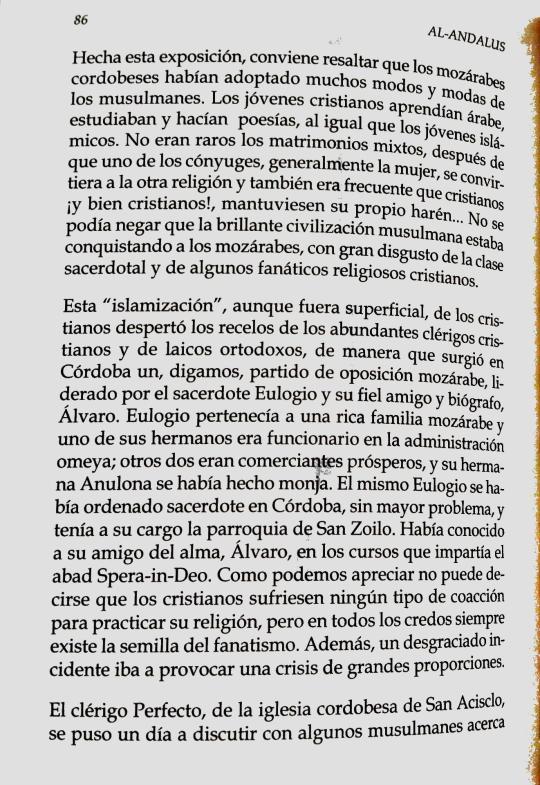
Having made this exposition, it is worth highlighting that the Mozarabs of Cordoba
had adopted many ways and fashions of the Muslims. Young Christians learned Arabic, studied and wrote poetry, just like the Islamic youth. Mixed marriages were not uncommon, after one of the spouses, usually the woman, converts to the other religion and it was also common for Christians, and very Christians, to maintain their own harem... It could not be denied that the brilliant Muslim civilization
was conquering the Mozarabs, to the great displeasure of the priesthood class and some Christian religious fanatics.
This "Islamization", even if it was superficial, of the Christians aroused the
suspicions of the abundant Christian clerics and Orthodox laymen, of way that a, let's say, Mozarabic opposition party emerged in Córdoba, led by the priest Eulogio and his faithful friend and biographer, Álvaro. Eulogio belonged to a rich Mozarabic family and one of his brothers was official in the Umayyad administration; two others were merchants
prosperous, and his sister Anulona had become a nun. Eulogius himself
had been ordained a priest in Córdoba, without much problem, and had his
charge of the parish of San Zoilo. He had met his soul friend, Alvaro in the courses taught by Abbot Spera-in-Deo. As we can see, It can be not said that Christians suffered type of coercion to practice their religion, but in all faiths there is always the seed of fanaticism. Furthermore, an unfortunate incident was going to cause a crisis of great proportions.
The clergyman Perfecto, from the Cordoban church of San Acisclo, one day began to argue with some Muslims about
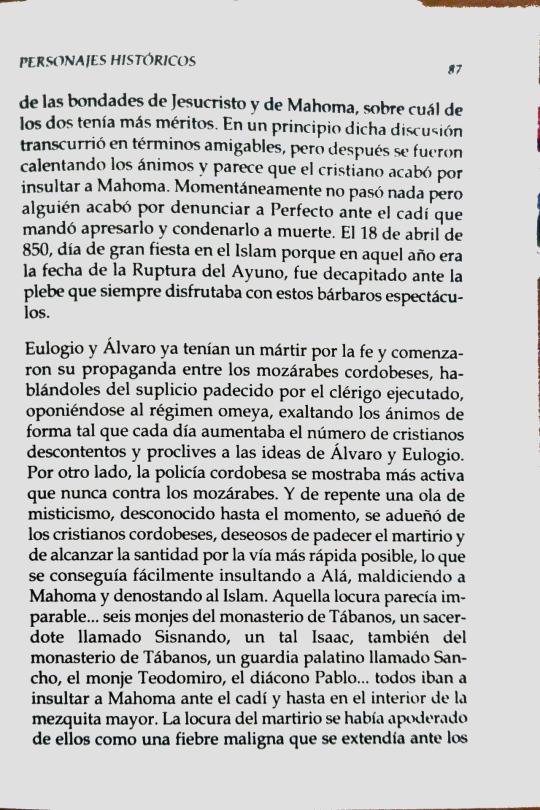
of the goodness of Jesus Christ and Muhammad, about which of the two had more merits. At first the discussion was on friendly terms, but later tempers were heating up and it seems that the Christian ended up insulting Muhammad. Momentarily nothing happened but someone ended up reporting Perfecto to the the cadi who ordered him to be arrested and sentenced to death. On April 18, 850, day of great holiday in Islam because that year was the date of the Breaking of the Fast, it was beheaded before the plebs who always enjoyed these barbaric spectacles.
Eulogio and Álvaro already had a martyr for the faith and began their propaganda among the Mozarabs of Cordoba, telling them about the torture suffered by the clergyman executed, opposing the Umayyad regime, raising spirits in such a way that every day the number of discontented Christians inclined to the ideas of Álvaro and Eulogio. On the other hand, the Córdoba police were more active than never against the Mozarabs. And suddenly a wave of mysticism, unknown until moment, took over the Christians of Cordoba, eager to suffer the martyrdom and achieving sainthood in the quickest way possible, which was achieved
easily insulting Allah, cursing Muhammad and reviling Islam. That madness seemed unstoppable...six monks from the Tábanos monastery, a priest named Sisnando, a certain Isaac, also from the Tábanos monastery, a guard palatine named Sancho, the monk Teodomiro, the deacon Pablo... they all went to insulting Muhammad before the qadi and even inside the main mosque. The madness
of martyrdom had taken hold of them like a malignant fever that spread before the
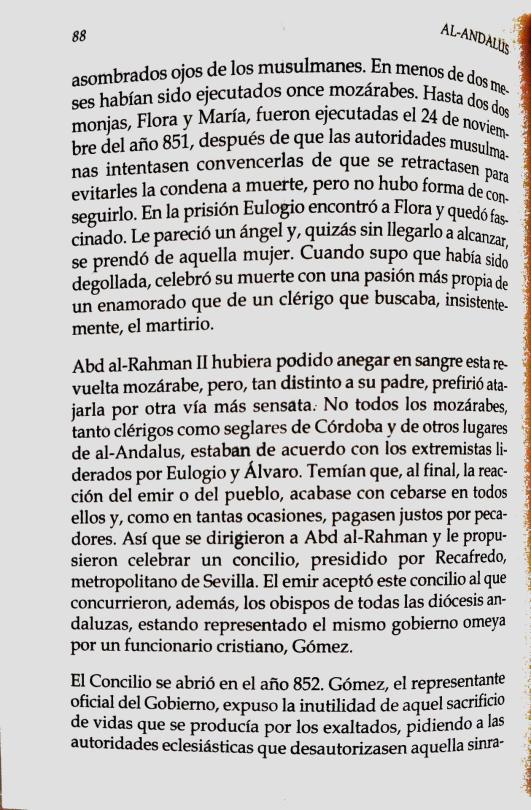
amazed eyes of the Muslims. In less than two months they had been eleven Mozarabs executed. Even two nuns, Flora and María, were executed on November 24, 851, after the Muslim authorities tried to convince them to recant to avoid the death sentence, but there was no way to achieve it. In prison Eulogio found Flora and was fascinated. It seemed like a
angel and, perhaps without reaching him, he fell in love with that woman. When
knew that she had been beheaded, he celebrated her death with a greater passion typical of a lover than of a clergyman who was insistently seeking,
the martyrdom.
Abd al-Rahman II could have drowned this revolt in Mozarabic blood, but, so different from his father, he preferred to tackle it by another sensiblebway. Not all the Mozarabs, both clerics and laymen of Córdoba and from other places in al-Andalus, agreed with the extremists
led by Eulogio and Álvaro. They feared that, in the end, the emir's reaction
or the town, ended up attacking all of them and, as in so many sometimes, the righteous paid for sinners. So they approached Abd al-Rahman and proposed holding a council, presided over by
Recafredo, metropolitan of Seville. The emir accepted this council to which, in addition, the bishops of all the Andalusian dioceses attended, the Umayyad government itself being represented by a Christian official, Gómez.
The Council opened in the year 852. Gómez, the official representative of the
Government, exposed the futility of that sacrifice of lives that occurred
by the exalted, asking the ecclesiastical authorities to disavow that non-
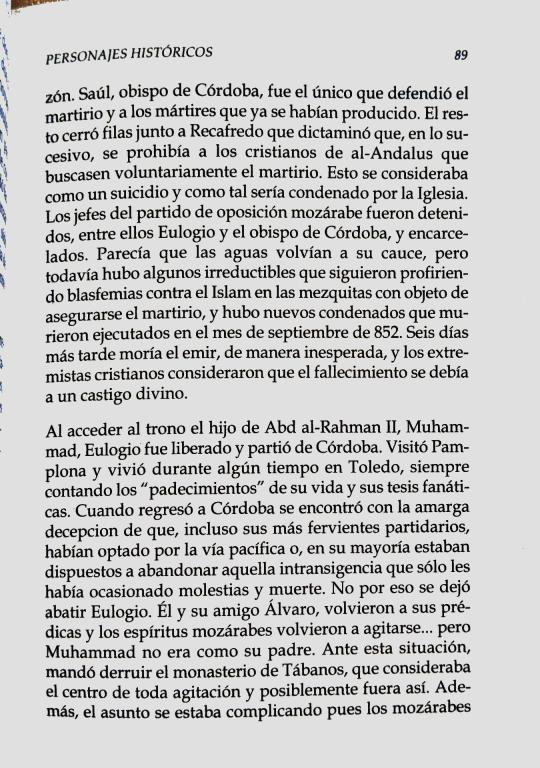
sense. Saúl, bishop of Córdoba, was the only one who defended martyrdom and the martyrs that had already occurred. The rest closed ranks with Recafredo who
ruled that, from now on, the Christians of al-Andalus were prohibited from
voluntarily seek martyrdom. This was considered suicide and
as such he would be condemned by the Church. The leaders of the Mozarabic opposition party were arrested, among them Eulogio and the bishop of Córdoba, and imprisoned. It seemed that the waters were returning to their channel, but there was still some irreducibles who continued uttering blasphemies against Islam in the
mosques in order to ensure martyrdom, and there were new convicts who were executed in the month of September 852. Six days later the emir died, unexpectedly, and the Christian extremists considered that the death was due to divine punishment.
When Abd al-Rahman II's son, Muhammad, acceded to the throne, Eulogius was released and left Córdoba. He visited Pamplona and lived for some time in Toledo, always recounting the "sufferings" of his life and his fanatical theses. When he returned to Córdoba he was met with the bitter disappointment that, even his most fervent supporters had opted for the peaceful route or, for the most part, were willing to abandon that intransigence that had only caused inconvenience and death. That's not why Eulogio let himself be discouraged. Him and his friend Álvaro, they returned to their preachings and the Mozarabic spirits stirred again... but Muhammad was not like his father. Faced with this situation, he ordered the demolition of the Tábanos monastery, which he considered the center of all unrest and possibly it was like that. Furthermore, the matter was becoming complicated because the Toledoan
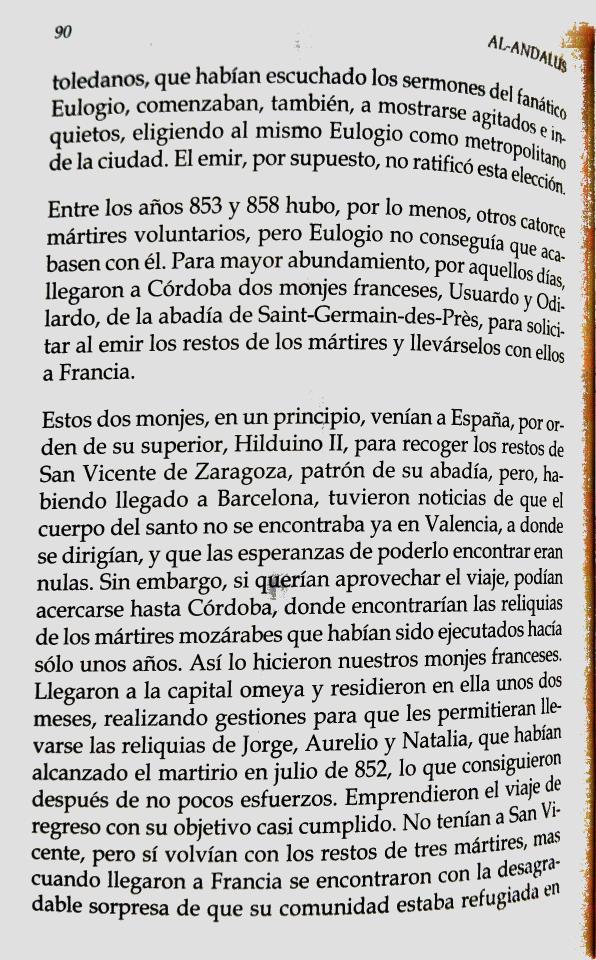
Mozarabs who had listened to the sermons of the fanatic Eulogio, were also beginning to appear agitated and restless, choosing Eulogio as metropolitan of the city. The emir, of course, did not ratified this election.
Between the years 853 and 858 there were at least fourteen other martyrs volunteers, but Eulogio couldn't get them to finish him off. For more abundance, in those days, two French monks arrived in Córdoba,
Usuard and Odilard, from the abbey of Saint-Germain-des-Près, to request the remains of the martyrs from the emir and take them with them to France.
These two monks, at first, came to Spain, by order of their superior, Hildouin II, to collect the remains of S. Vicente de Zaragoza, patron of his abbey, but, having arrived in Barcelona, they had news
that the saint's body was no longer in Valencia, where it was led, and that the hopes of being able to find him were zero.
However, if they wanted to take advantage of the trip, they could go to Córdoba,
where they found the relics of the Mozarabic martyrs who had been
executed only a few years ago. This is what our French monks did. They arrived in the Umayyad capital and lived there for about two months, taking steps to allow them to take the relics of Jorge, Aurelio and Natalia, who had achieved martyrdom in July 852, what they achieved after quite a bit of effort. They started the journey
back with his goal almost accomplished. They did not have S. Vicente, but they did returned with the remains of three martyrs, but when they arrived in France they found themselves with the unpleasant surprise that their community was
refugee in
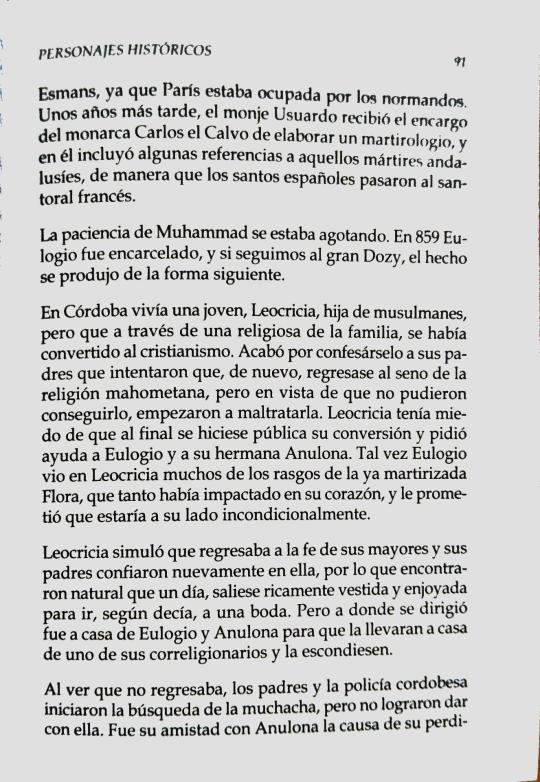
Esmans, since Paris was occupied by the Normans. A few years later, the monk Usuard received the commission from the monarch Charles the Bald to prepare a
martyrology, and in it he included some references to those Andalusian martyrs,
so that the Spanish saints passed to the French saints.
Muhammad's patience was wearing thin. In 859 Eulogio was imprisoned, and if we follow the great Dozy, the event occurred in the following way.
In Córdoba there lived a young woman, Leocricia, daughter of Muslims, but through a nun in the family, had converted to Christianity. She ended up confessing it to his parents who tried to get her to return to the bosom of the Mohammedan religion, but since they could not obtain it,
they began to mistreat her. Leocricia was afraid that in the end her conversion would become public and asked Eulogio and his sister Anulona for help. Maybe Eulogio saw
in Leocricia many of the traits of the already martyred Flora, who had so much
shocked in his heart, and he promised that he would be by his side unconditionally.
Leocricia pretended to return to the faith of her elders and her parents trusted
again in it, so they found it natural that one day, it would come out richly dressed and jeweled to go, as she said, to a wedding. But where she went to Eulogio and Anulona's house so they could take her to the house of one of her coreligionists and hid her.
Seeing that she did not return, the parents and the Córdoba police began the search
of the girl, but they could not find her. It was his friendship with Anulona that
cause of her perdi-
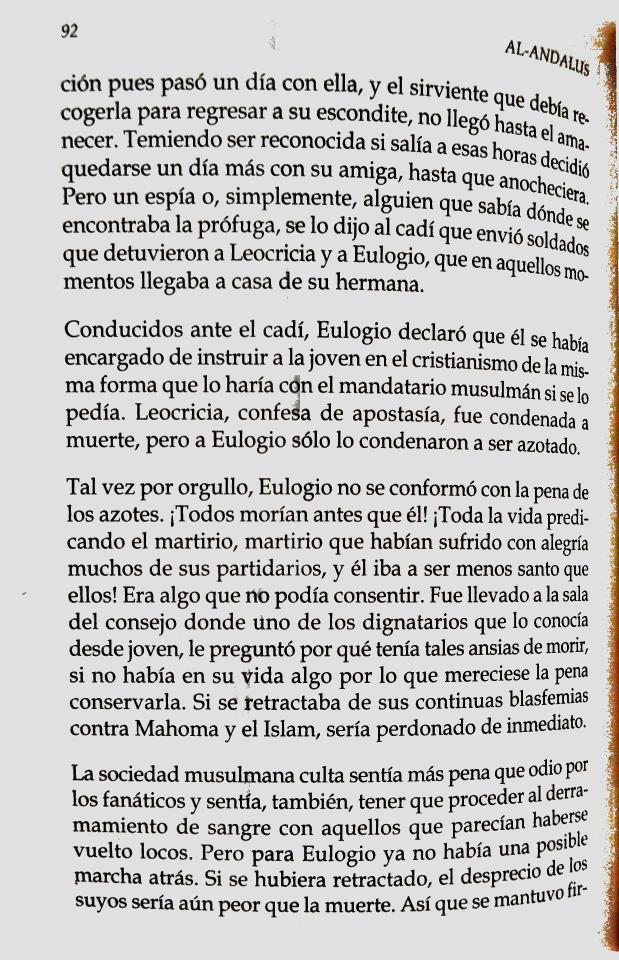
tion because she spent a day with her, and the servant who was to pick her up to
return to her hiding place, she did not arrive until dawn. Fearing to be recognized if she went out at that time, she decided to stay one more day with her friend, until nightfall. But a spy or simply someone who knew where the fugitive was, told the cadi who sent soldiers to arrest Leocricia and Eulogio, who at that time was reaching
his sister's house.
Brought before the cadi, Eulogio declared that he had taken care of instruct the young woman in Christianity in the same way as he would with the Muslim leader if he asked. Leocricia, confessed of apostasy,
was sentenced to death, but Eulogio was only sentenced to be whipped.
Perhaps out of pride, Eulogio did not settle for the punishment of whipping. Everyone died before him! All his life preaching martyrdom, martyrdom that many of his supporters had suffered with joy, and he
I was going to be less holy than them! It was something he couldn't consent. He was taken to the council room where one of the dignitaries who knew him since he was young, he asked him why he had such a desire to die, if there was no something in his life worth keeping. If he retracted
of his continued blasphemies against Muhammad and Islam, he would be forgiven immediately.
The cultured Muslim society felt more pity than hatred for the fanatics and they also felt that they had to proceed to shed blood with those who seemed to have gone crazy. But for Eulogio there was no longer a possible retreat. If he had retracted, the contempt of his people would be even worse than death. So he stood firm
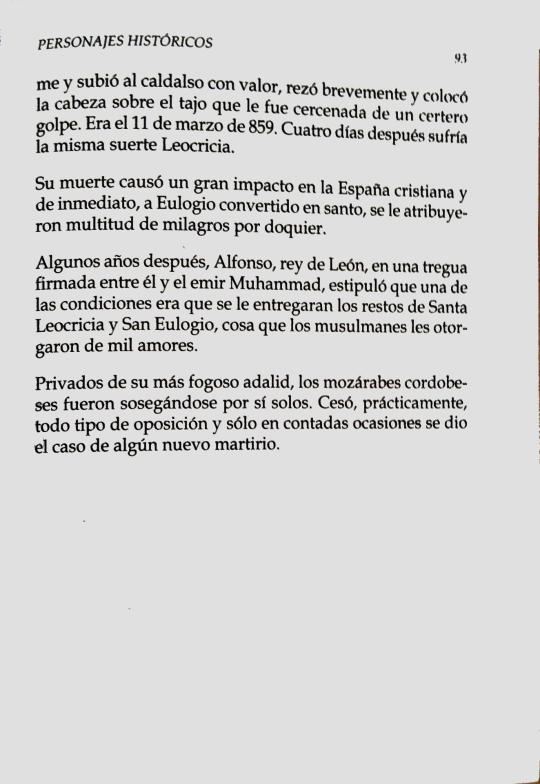
and he bravely climbed into the scaffold, prayed briefly and placed his head on the
slash that was severed with a well-aimed blow. It was March 11, 859. Four days later Leocricia suffered the same fate.
His death caused a great impact in Christian Spain and immediately,
Eulogio became a saint, a multitude of miracles were attributed to him
everywhere.
Some years later, Alfonso, king of León, in a truce signed between him and the emir Muhammad, stipulated that one of the conditions was that the remains of S. Leocricia and S. Eulogio would be handed over, something that Muslims gave them a thousand loves.
Deprived of their most fiery champion, the Mozarabs of Córdoba were calming down on their own. Practically all types of opposition ceased and only on rare occasions there was the case of a new martyrdom.
#al andalus. historical figures#al andalus. personajes históricos#al andalus#book scans#al andalus history#bookblr#historyblr#spanish history#emirate of cordoba#eulogio de córdoba#álvaro de córdoba#emirato de córdoba
15 notes
·
View notes
Note
Hi!! You're an incredible artist! I hope you won't think it's rude, but I was wondering what draws you to guro? I like whump and horror, but guro is often too much for me, and I'm curious about your point of view!
If it's too personal, you don't have to answer!
thank you so much for your kind words! i don't think your message is rude, thank you for asking in such a nice way.
sorry for a long text, hope its not too TMI
i was drawn to the themes of suffering and torture for as long as i remember. as a kid i was spending a lot of time in the orthodox church and i was absolutely fascinated by the stories of christian martyrs, and would daydream endlessly about their violent deaths, imagining myself in their place. I told my parents several times that i dream of being a martyr and how sad i am that its not those times anymore. my parents were happy to hear it, and thought it showed how devoted to christ i am. i was drawing people tortured and in prisons, and below i would write "suffer for christ" or "this is what happens to non-believers". when i did pretend play, i suggested my mom to play "kitty" with me, where i play as a kitty, and she beats me up. Violence and forms of suffering were always on my mind as i was growing, and i am still fascinated and drawn to it.
as to why i was drawn to this from the start, i am not sure. maybe it's because i was beaten and degraded/abused a lot and mixed love for my parent with the pain it was giving me. maybe it's how my mental illness manifested itself when i was young, or maybe that's just how my brain is wired
right now i am well medicated and lead a very calm non-self-destructive life. i am happy that i can express my violent ideas in art instead of seeking death irl :>
13 notes
·
View notes
Text
Traintober 2023: Day 16 - Purpose
What Is An Engine's Purpose, Godred?

What is an engine’s purpose?
It’s an interesting question. Theoretically, there is only one answer, and it’s a simple answer above all. There is no deep philosophical debate or grand mystery that spans out across the universe for all time to ponder.
And yet, Godred pondered it. Lying on his side, crumpled, he wondered quietly about his purpose. The little engine tried to take a breath, only to groan and almost choke on a rivet that had ripped its way out of his smokebox. Everything hurt. There was a tree branch that had managed to lodge itself through his cab and into his firebox – now it was beginning to smoulder as the burning coals of his firebox set it alight. Soon his entire cab would be a raging inferno.
“So… what is an engine’s purpose?” asked a voice. Godred blinked his only working eye open, trying to shift the grit and dirt out of his eyelid before gazing around. A figure dressed all in white stepped forwards, gazing down at the young engine.
“Wha—” Godred didn’t even manage to complete a single word before he was reduced once more to a hacking cough, one which rattled his frames and managed to finally rip his safety valve from where it had been bent at an oblong angle. The clang of the valve hitting the ground resounded across Culdee Fell.
“Ah, I see,” sighed the figure. “You did not realise it until too late, did you?” Godred didn’t reply – he felt that the answer to that question was a little too obvious, considering his current position. His mangled wheels groaned; an axle snapped and the upper half ripped into his motion, dragging a pained moan from his tattered vocal chords.
The figure knelt down in front of Godred, placing a comforting hand on his cheek. It came away red with blood; but Godred’s crew had managed to jump to safety.
“I… I was blind,” admitted Godred, finally able to speak more than a single syllable. “I… destroyed myself.” The figure sighed, stepping back for a second to size Godred up. Godred did the same.
The figure was dressed in a white robe, one that looked not too dissimilar to the robes worn by the Monks at the church at the foot of Culdee Fell. He had a plain rope cincture tied around his waist, and plain sandals on his feet. Most interestingly, he had a long, white beard and a gentle, loving smile.
“I suppose you were, dear engine,” the figure said. “Though I wonder if that was your purpose?” Godred frowned.
“What’s the supposed to mean?” he demanded. The figure hummed for a moment, before gently sitting down on a boulder beside where Godred had landed.
“Your purpose as an engine was to transport passengers and freight from one place to another, correct?” the figure asked. Godred agreed. “Well, that was your purpose until you derailed. Now, you are a martyr, or perhaps a warning. The railway will forever remember you, and you shall forever act as the spectre that hangs over them and wards them from recklessness.”
Godred scowled.
“That sounds like some nonsense that a priest would say! Are you one of them? Do you work at the church?”
The figure considered for a moment.
“That is one way to say it,” he said after a moment. “I definitely am a Christian – perhaps you’ve heard of me?” Godred snorted.
“Unlikely. The only great Christian person in this region is Saint Machan, and he’s been dead nearly 1500 years!”
“Ah, so you have heard of me.” Godred’s eyes went wide. He looked back – his corporeal body lay smashed and destroyed behind him, but he could see it! He could see every inch of his wrecked boiler, could see his battered cab and mangled valve gear.
“I’m… dead?” whispered Godred, almost fearfully. Saint Machan nodded, and wordlessly strode over to the wreck of the steam engine. He performed a few quick ceremonies over the husk of an engine, then turned to Godred.
“My purpose, young Godred, was once to spread the good word. Now, I bring the tortured souls the mountain steals to the afterlife, where they may find peace with god.” Godred shook his head, horrified – he could shake his head.
“No… no… it can’t be! I’m the Number One! I cannot be dead – I am eternal, I had the luck of Godred on my side!” Saint Machan waited patiently for Godred to finish babbling, then turned to the spirit staring mournfully at his former body.
“So, any last rites?”
Back to Master Post
#fanfiction writer#weirdowithaquill#railway series#thomas the tank engine#railways#traintober#traintober 2023#ttte godred#ttte Saint Machan#culdee fell#an engine's purpose
23 notes
·
View notes
Text
Have I pitched my Acts sitcom to you guys yet? I don’t think so.
Basically, I want a sitcom made based on the book of Acts with a combination of Christian and secular writers and creatives. Preferably a few of the Christians will have served as committee members in some capacity in their local churches. The goal, essentially, is to riff on the human messiness and frequent absurdity of the early church with good humor and some irreverence, but never with God or the Gospel as the butt of the joke.
Characters:
Peter is the young, energetic guy who suddenly has Administrative Responsibilities. He’s energized by his evangelism/discipleship work, but he’s always Tired and Unwell while trying to manage the leadership of the church.
John is overly affectionate. He’s always hugging people he barely knows, giving people really enthusiastic compliments, that sort of thing.
Luke is quiet and nerdy, maybe even a little nebbish. When he speaks, it’s usually to ask people vaguely uncomfortable questions “for his book.” If you want to go mocumentary style with the show, Luke’s interviews can be the framing device.
Paul is generally a pretty chill guy, but he’s super gung-ho about suffering for the Gospel. People are a little weirded out his wannabe martyr energy.
John Mark is really, really annoying in some way. Like maybe he’s always playing his original music on the lyre and he’s really bad at it. Maybe he’s really flakey and irresponsible and sort of has Jean-Ralphio energy. Paul, in particular, finds him really annoying and always looks absolutely miserable when they’re in a scene together. When Barnabas eventually suggests bringing John Mark on a missionary journey, the “sharp disagreement” is just Paul going “oh hell no” and walking straight out of the room.
Lots of women and people of different races represented, particularly as church members. Lydia should be a major character, although I don’t quite know what her personality should be. Rhoda (the servant who slammed the door in Peter’s face) would be a fun inclusion too. Racial diversity should at least reflect the actual ancient Mediterranean, although I don’t think I’d be super picky about which specific characters are which races.
Ongoing plots:
The organizational nightmares of running a church is a running theme. Basically just crib from the funniest parts of church government and organization. Things are poorly run and disorganized and people have different opinions and everything somehow still gets done. This stuff can have Parks and Rec energy.
Lots of conflict of personality issues, but also an increasing closeness between the Apostles and members of the church
Lots of missionaries getting run out of town in increasingly comedic ways. Like, I want Paul and Barnabas running out of Random Roman City #52 while getting pelted with eggs.
Lots of what I can only describe as late night theology. Like when you’re sleep deprived and discussing the deep questions of Scripture with your friends in the car, often arriving at weird conclusions. Lots of that kind of stuff. Also, in general, the characters talk about God the way Christians actually do-- casually, often humorously, sometimes irreverently, as an important part of life and not just a serious subject for Important Conversations
Paul’s Roman Citizenship is milked for all it’s worth. Yes, it gets him out of imprisonment and torture, but it also gets him out of like, minor municipal violations.
Episode plots:
Philip finds himself teleported to/from Ethiopia to convert the eunuch and, upon returning to Jerusalem, spends an episode getting startled by sudden movement (knocking things over, accidentally slapping people) because he thinks he’s gonna get teleported again. There’s a long scene where Philip tries to interrogate Peter and find out if teleportation is just like a standard Holy Spirit powerup or if it was a one-time deal. Peter’s just getting progressively more and more confused.
Saul’s conversion from Ananias’s perspective. He’s woken up in the middle of the night and told to go pick Saul the Murder up and take him home. He’s sleep-deprived and low-key freaking out and he hasn’t gone grocery shopping so he’s running around trying to find some food for Saul at 2am. Episode ends with Ananias collapsed sideways on his bed and Paul coming and pulling a blanket over him.
Extended physical comedy scene where they’re lowering Paul over the wall in the basket, but the ropes are uneven and he’s getting tossed from side to side and the guy at the bottom isn’t in place yet and they’re all trying really hard to be inconspicuous.
There’s a whole road episode where it’s just everyone cooped up on a ship or in the middle of the desert or something while they’re on their way to spread the gospel in a new city. They all get on each others nerves. Somebody goes a little bit stir-crazy and loses it.
The show shouldn’t be ashamed that it’s about people spreading the Gospel, but I don’t want lots of scenes that try to evangelize the viewer. We’re not trying to proselytize, we’re trying to make light of the human messiness that is life in the church. Embrace anachronism (I’d love to see some modern church potlucks, for example), but also lots of nerdy historical and Biblical/theological jokes.
There’s such a dearth of genuinely funny Christian entertainment, particularly that which (a) is entertaining to seculars as well and (b) actually embraces the Bible and not just some form of cultural Christianity. And Acts is right there! It’s hilarious! Top tier sitcom material! Somebody fund me.
@citrussunrises other friends, anything to add?
#make it happen#i could go on#for pages and pages#genuinely wish i were funnier i would totally crank out a treatment if i had the requisite skills#Jesus laughed#pontifications and creations#please feel free to add your own ideas!#Bible humans
328 notes
·
View notes
Text
More Jane Eyre/The Charioteer parallels!
@nurseadriansbrother Your Jane Eyre post! I love it! I've linked to it here.
I had completely forgotten what a wild imagination young Jane has, no wonder all the adults were a little terrified of her (as Ralph is of Laurie!) I mean that little paragraph of her in bed getting scared so echoes the start of chapter one in TC. My favourite bit is where Mary says ‘he made the emergency known at once’ (ie that he couldn’t sleep (!)
I’m so glad you said that thing about Rochester being brought low so that they can come together. That’s always been in my mind as Charlotte Bronte’s ‘solution’ but I thought it sounded a bit over-dramatic, but I do think she feels she has to practically blind and maim him first!! Very strange, and I suppose there is definitely a parallel with the ending of TC although I always worry about Ralph being brought low because I wonder if he can really accept Laurie taking care of him. Although I do believe that’s the only way it could work. Or some kind of equality at least. And Rochester has the thing about wanting Jane to be honest, I had forgotten about him using that word ‘master’, Wow! It makes me worry if Laurie is just lying to Ralph to make him feel better, he’s going to have to be so careful about that. He seems to struggle so hard with confrontation.
God, I had completely forgotten the references to suicide in Jane Eyre. She is so steadfast. I remember to this day my English teacher explaining to us callow teenagers in words of one syllable what the societal dangers were of Jane becoming Rochester’s mistress.
Jane’s internal monologue is so interesting, yes, she struggles so hard to be fair and reasonable, and trying to take on Helen’s virtues the way Laurie tries to do with Andrew – that bit after the Bunny car scene where he thinks what would Andrew say…….That’s funny though because when I was looking into Ralph’s childhood and wondering how strict his ‘Christian home’ was, and then I re-read that bit in the ‘break-up’ scene where Laurie says he is like someone suffering for a cause, I immediately thought ‘martyr’ and I haven’t been able to un-see it! Helen Burns! And all those horrible books about Saints getting tortured Jane used to read….
And Jeepers – what’s interesting is that Mr Brocklehurst presents his hypocrisy as very pragmatic, and in a way I think that’s Jepson’s excuse too. I always think of Straike’s reference to Jepson’s hypochronia!
OK and finally – gothic horror!! You read my mind! One of my little theories about Ralph is that he is always saying ‘Don’t worry’ to Laurie and although that sounds like kindness, I always feel there is a little wind-up element to it, as in, ‘I wasn’t worrying, why do you think I would be?’ and I have this feeling of Ralph’s power kick (I’m sure entirely unconsciously) being to slightly frighten people and then be all nice and comforting. Sorry, have I just gone off the deep end or does that make sense?
7 notes
·
View notes
Text
I present to you The Venerable John Boswell, who should be remembered by every church and every Christian who considers themselves “open and affirming.”

If you have heard of John Boswell, you've probably heard of his name in conjunction with words like "controversial" or "disputed." This is an absolute shame, because I've been getting to know him and his work over the last couple of months for a different project, and I've come to think of him as "my dead friend." According to an (alive) friend in religious studies, "a saint is just a dead friend who can pray for you," so I am presenting him in the form of a traditional icon.
Iconography:
"The Venerable": in one sense bitterly ironic, since Professor Boswell died young. On the other hand it calls back to the Venerable Bede, also a historian whose work has been "challenged."
Tongue of flame: a traditional symbol for the Holy Spirit. One of the traditional gifts of the Holy Spirit is the gift of "speaking in tongues" and the "interpretation of tongues." Professor Boswell spoke or read at least 17 modern and classical languages.
Harvard Doctoral robes: a symbol of his academic achievement and authority. Professor Boswell was educated and worked in some of the most prestigious institutions in the world, and was briefly the chair of the Yale history department before he had to step down because of his illness. Someone like Thomas Aquinas probably would have considered him a social equal. He was not "a single controversial historian" with a couple of crackpot theories.
Palm frond: a traditional symbol for martyrs. In a very broad sense, a martyr is someone whose death can teach us something, or is otherwise "theologically significant." Professor Boswell died of AIDS in 1994. HIV/AIDS is not "God's judgment upon sinners," as some conservative fanatics believe. It is a mindless disease that governments and other institutions (including churches) allowed to spread unchecked in gay communities for years, simply because they were gay. It was only when "respectable" people began coming down with it that medical research began in earnest and public health protocols were put into practice. It was, and still is in some places, a public health disaster even now that effective treatments for it exist. Professor Boswell was one of the vanguard of AIDS patients who died before effective treatments were available, and part of a generation of queer elders who should still be with us. He would be 76 years old in 2023.
"The crown of glory for me is with you": this is a line from "The Passion of SS. Serge and Bacchus," which Professor Boswell translated into English for the first time, which makes it widely available to people outside of small, elite academic circles. In the legend, Bacchus has been martyred and has appeared to Sergius in a vision. He uses this line to encourage Sergius to stay strong until they can be reunited in heaven. In another sense, the icon of Professor Boswell is encouraging the people who admire him to keep up his work. Keep digging up subversive, queer Christian history, and keep challenging him. We didn't stop writing English history after the Venerable Bede, and we won't stop writing LGBTQ Christian history after the Venerable Boswell.
Hagiography:
Professor Boswell, known as Jeb to his friends and family, was said to be remarkably kind, generous, funny, and sensitive. He was beloved by his students and respected by his colleagues. He became a devoted Roman Catholic when he was a teenager, and attended Mass daily. He was approachable and open regarding the challenges of being both gay and Christian, and was also openly critical of the Church in spite of (or perhaps because of) his personal faith. He challenged both religious conservatives, for obvious reasons, and also "enlightened secularists" whose dogma held that "organized religion," and Christianity in particular, was the root cause of all homophobic discrimination in the world. There are many people who would have preferred to let his life and work quietly slip into the past, and there are even some who have actively tried to erase him, but John Boswell will not be erased. In my opinion, Professor Boswell should be officially commemorated by every church that considers itself "Open And Affirming." This modern movement builds on work done by Professor Boswell, and he must be respected in all of his twinky, flamboyant, brilliant, and life-giving glory. He declared that queer people could know God without shame or self-censorship, and that the Church could be made to repent and welcome us as it once did.
Further Reading:
If you have a couple of hours, I recommend the single known video recording of one of his lectures: Jews, Gay People, and Bicycle Riders (1986). This is an excellent introduction to his work.
https://www.christiancentury.org/article/first-person/john-boswell-s-faith-lit-generation
https://qspirit.net/john-boswell-historian-gays-lesbians/
https://www.findagrave.com/memorial/17004797/john-eastburn-boswell
https://www.wm.edu/as/dean/boswell/about/index.php
https://lgbtqreligiousarchives.org/profiles/john-boswell
https://sourcebooks.fordham.edu/pwh/index-bos.asp
https://archives.yale.edu/repositories/12/resources/5188
38 notes
·
View notes
Text
Spoiler Review of S4 Episode One
Ok so I gave a non spoiler review of episodes 1-3 buuuut it is now time for the spoilers I will be tagging these so no one who does not want to see them will. If somehow, you are reading this part, please please please be aware that from this sentence forward there are spoilers for season four episode 1 of The Chosen. Ok? Ok.
…
Episode One:
Ok so literally episode one John the Baptist is martyred. And it is breathtakingly beautiful. The dancer who played Salome was phenomenal, I don’t think she had a single line, her whole thing was practicing and performing the dance which I feel like really shows how this was all Herodias’ idea and she was really just a pawn. At the same time, we flashback to young Mother Mary visiting Elizabeth and Zechariah, which was funny and sweet and so heartwarming. It really is odd to see a woman clearly in her 70s or even 80s pregnant but knowing the story it just made me so happy. We also see Joanna going to tell the disciples and Jesus about John. It’s all intercut between Zechariah’s prophecy about John as a baby, the party, Joanna, and the actual death of John. The scene of the execution is somehow beautiful even as we know something horrible is happening. As John is being led away, he quotes what Jesus had his disciples tell him, “The lame walk, the blind see, the dead are raised,” and he says, “The way of the Lord is prepared.” Which just sent shivers down my spine. We see the silver platter John’s head will be served on and the soldier says that usually it’s used for a wedding banquet to which John says, “I’ve never been to a wedding banquet, but I’m going to one.” Which again, I’m just sobbing at this point. Right as John is about to die, he looks out a window and sees a spotless lamb feeding outside, like a final sign that his mission is fulfilled. Obviously we don’t see a severed head, but the swing of the axe is just as impactful. We cut to Jesus by himself, as if already preparing for the news. When he is told, we see him mourn. Rip his clothes, and cover himself in dirt. It’s heartbreaking to say the least. Also, it is important to note that Ramah returns and everyone is gathering together. Then, we see Joanna arrive and tell Andrew, and then everyone else. The last thing we see is Jesus approaching the group, torn clothes, dirt on his face, looking…disillusioned? It’s hard to describe it. Almost like he’s been too emotionally exhausted to have a readable expression.
Another thing to note, was that Zebeddee and sons have the olive oil ready and are giving it to the local synagogue for ritual purposes. Yousef says it is to benefit local enterprise, but Rabbi Akira is skeptical. Tamar goes with them but is not allowed in the synagogues being both a woman and a Gentile, obviously upsetting her. (Big James offers to stay with her instead of going in!!!!!!! The ship is real!!!!!)
Oh and I just remembered that Salome did have a line and it was just to say, “Anything?” When Herod says he’ll give her anything after the dance.
The interweaving of baby John and John’s execution was beautifully done. I was sobbing. The moment Zechariah can speak again, he begins prophesying and we hear it over John being led in by the soldiers. I like that John seemed nervous (as obviously anyone would be) but he wasn’t necessarily scared. It was that last moment of seeing the lamb that made him smile just as he died. Oh wow like I said I was crying.
It’s also incredibly hard to watch Jesus cry. I expected it to be, but obviously being a Christian and a follower of Jesus makes it so much harder. Especially after the love and laughter we’ve seen him experience as well. They do not shy away from humanity and that is such a welcomed thing.
Episode One was expected, but still managed to be utterly brilliant in writing and storytelling. We all knew John’s death was coming and it was made into a realistically sorrowful but beautiful reality. I cannot wait until I have it at my fingertips to watch again and again.
So that was episode one. Episode two coming soon!
10 notes
·
View notes